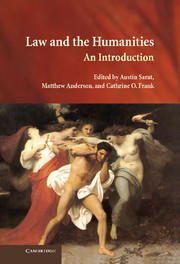Book contents
- Frontmatter
- Contents
- Contributors
- Acknowledgments
- Introduction: On the Origins and Prospects of the Humanistic Study of Law
- I PERSPECTIVES ON THE HISTORY AND SIGNIFICANCE OF SCHOLARSHIP IN LAW AND THE HUMANITIES: THREE VIEWS
- II IDEAS OF JUSTICE
- III IMAGINING THE LAW
- 8 Imagining the Law: The Novel
- 9 Imagining Law as Film (Representation without Reference?)
- 10 Law and Television: Screen Phenomena and Captive Audiences
- 11 Imagining the Law: Art
- IV LINGUISTIC, LITERARY, AND CULTURAL PROCESSES IN LAW
- V INSTITUTIONAL PROCESSES
- Index
- References
9 - Imagining Law as Film (Representation without Reference?)
Published online by Cambridge University Press: 20 January 2010
- Frontmatter
- Contents
- Contributors
- Acknowledgments
- Introduction: On the Origins and Prospects of the Humanistic Study of Law
- I PERSPECTIVES ON THE HISTORY AND SIGNIFICANCE OF SCHOLARSHIP IN LAW AND THE HUMANITIES: THREE VIEWS
- II IDEAS OF JUSTICE
- III IMAGINING THE LAW
- 8 Imagining the Law: The Novel
- 9 Imagining Law as Film (Representation without Reference?)
- 10 Law and Television: Screen Phenomena and Captive Audiences
- 11 Imagining the Law: Art
- IV LINGUISTIC, LITERARY, AND CULTURAL PROCESSES IN LAW
- V INSTITUTIONAL PROCESSES
- Index
- References
Summary
Today we have law on the books, law in action, and now, law in the image…Law lives in images that today saturate our culture and that have a power all their own.
– Austin SaratWhat has film to do with law? Film can be about law, or ostensibly about law. It can reenact famous cases and controversies, or focus on various features of the legal system. Law films can turn viewers into mock jurors, investigators, and advocates. They can show us how the adversarial process reconstructs historic reality inside the courtroom, and how it enacts a dramatic reality of its own. Films can also use any of these topics as a pretext for launching a different sort of story altogether, a melodrama say, or a mystery, in which law serves as no more than a prop or plotting device. Just as law stories may set a story in motion that ultimately has little to do with law itself, the converse is also true. Films not apparently about law may provide insights into analytical methods, social values, and community aspirations that lie at the heart of the legal mind and culture. The quest for justice, and how it goes astray, the clash between vengeance and mercy or between the formality of rules and the free play of equity, the struggle to solve a mystery amid the infinite complexities of human motivation and the recursive contingencies of time and circumstance – each of these themes has a place in the legal process.
- Type
- Chapter
- Information
- Law and the HumanitiesAn Introduction, pp. 241 - 268Publisher: Cambridge University PressPrint publication year: 2009
References
- 1
- Cited by



